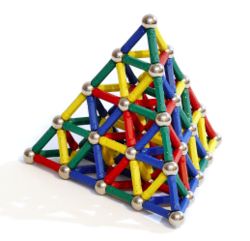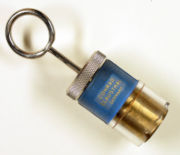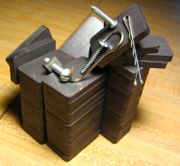Magnet
2007 Schools Wikipedia Selection. Related subjects: Electricity and Electronics
A magnet is an object that has a magnetic field. It can be in the form of a permanent magnet or an electromagnet. Permanent magnets do not rely upon outside influences to generate their field. They occur naturally in some rocks, but can also be manufactured. Electromagnets rely upon electric current to generate a magnetic field - when the current increases, so does the field.
Magnets are attracted to, or repelled by, other materials. A material that is strongly attracted to a magnet is said to have a high permeability. Examples of materials with very high permeability include iron and steel. Liquid oxygen is an example of something with a low permeability, and it is only weakly attracted to a magnetic field. Water has such a low permeability that it is actually slightly repelled by magnetic fields. Everything has a measurable permeability: people, gases, and even the vacuum of outer space.
The SI unit of magnetic field strength is the tesla, and the SI unit of total magnetic flux is the weber. 1 weber = 1 tesla flowing through 1 square meter, and is a very large amount of magnetic flux.
Physical origin of magnetism
Permanent magnets
Normal pieces of matter are composed of particles such as protons, neutrons, and electrons; and all of these have the fundamental property of quantum mechanical spin. Spin gives each one of these particles an associated magnetic field. Because of this, and the fact that the average microscopic piece of matter contains huge numbers of these particles, it would be expected that all matter would be magnetic. Even antimatter would have magnetic characteristics. However, everyday experience shows that this is not the case.
Within each atom and molecule, the spin of each of these particles is highly ordered as a result of the Pauli Exclusion Principle. However, there is no long-range ordering of these spins between atoms and molecules. Without long-range ordering, there is no net magnetic field because the magnetic moment of each one of the particles is canceled by the magnetic moment of other particles.
Permanent magnets are special in that long-range ordering does exist. The highest degree of ordering exists within magnetic domains. These domains can be likened to microscopic neighborhoods in which there is a strong reinforcing interaction between particles, and as a result, a great deal of order. The greater the degree of ordering within and between domains, the greater the resulting field will be.
Long-range ordering (and the resulting strong net magnetic field) is one of the hallmarks of a ferromagnetic material.
Electronic generation of magnetism
Electrons play the primary role in generating a magnetic field. Within an atom, electrons can exist either individually or in pairs within any given orbital. When they are paired, the individuals in that pair always have opposite spin—one up, one down. The fact that the spins have opposite orientation means that the two cancel one another. If all electrons are paired, no net magnetic field will be generated.
In some atoms, there are electrons that are unpaired. All magnets have unpaired electrons, but not all atoms with unpaired electrons are ferromagnetic. In order for the material to become ferromagnetic, not only must there be unpaired electrons present, but those unpaired electrons must interact with one another over long ranges such that they are all oriented in the same direction. The specific electron configuration of the atoms (as well as the distance between atoms) is what leads to this long-range ordering. Electrons exist in a lower energy state if they share the same orientation.
Electromagnets
An electromagnet, in its simplest form, is a wire that has been coiled into one or more loops. This coil is known as a solenoid. When electric current flows along the coil, a magnetic field is generated around the coil. The orientation of this field can be determined via the right hand rule. The strength of the field is influenced by several factors. The number of loops determines the surface area of interaction, the amount of current determines the amount of activity, and the material in the core determines electrical resistance. The more loops of wire and the greater the current, the stronger the field will be.
If the coil of wire is empty in the centre, it will tend to generate a very weak field. Different ferromagnetic or paramagnetic items can be placed in the centre of the core with the effect of magnifying the magnetic field, for example an iron nail. In addition, soft iron is commonly used for this purpose. The addition of these types of materials can result in a several hundred- to thousand-fold increase of field strength.
At distances which are large compared to the magnet's dimension, the observed magnetic field obeys an inverse cube law. This means that the field strength is inversely proportional to the third power of the distance from the magnet.
In the case of an electromagnet in contact with a flat metal plate, the force needed to separate the two will be greatest if the two surfaces are machined as flat as possible. The flatter the surfaces, the more points of contact between them, and the smaller the magnetic circuit's reluctance to the magnetic field.
Electromagnets find uses in many places, ranging from particle accelerators, to electric motors, to junkyard cranes, to magnetic resonance imaging machines. There are also specialized applications that involve more than a simple magnetic dipole, such as the quadrupole magnets used to focus particle beams.
If enough electric current is passed through the coil of an electromagnet, the magnetic force between neighboring loops of wire can cause the electromagnet to be crushed by its own magnetic field.
Characteristics of magnets
Permanent magnets and dipoles
All magnets have at least two poles: that is, all magnets have at least one north pole and at least one south pole. The poles are not a pair of things on or inside the magnet. They are a concept used to discuss and describe magnets. In the image at the top of this page, the poles look like specific locations, because the highest surface intensity of the field occurs at the poles, but this does not mean that they are specific locations.
To understand the concept of pole, it can be imagined that a row of people who are all facing the same direction and standing in line. While there is a "face" end of the line and a "back" end of the line, there is no one place where all of the faces are and all of the backs are. The person at the front of the face end has a back; and the person at the back end has a face. If the line is divided into two shorter lines, each one of the shorter lines still has a face end and a back end. Even if the line is pulled completely apart so that there are just individuals standing around, each one of the individuals still has a face and a back. This can continue without end.
The same holds true with magnets. There is not one place where all of the north or south poles are. If a magnet is divided in two, two magnets will result and both magnets will have a north and a south pole. Those smaller magnets can then be divided, and all of the resulting pieces will have both a north and south pole. In most instances, if the material continues to be broken into smaller and smaller pieces there will be a point where the pieces are too small to retain a net magnetic field. They won't become individual north or south poles though; instead, they will just lose the ability to maintain a net field. Some materials, however, can be divided down to the molecular level and still maintain a net field with both a north and a south pole. There are theories involving the possibility of north and south magnetic monopoles, but no magnetic monopole has ever been found.
North-south pole designation and the Earth's magnetic field
A standard naming system for the poles of magnets is important. Historically, the terms north and south reflect awareness of the relationship between magnets and the earth's magnetic field. A freely suspended magnet will eventually orient itself north-to-south, because of its attraction to the north and south magnetic poles of the earth. The end of a magnet that points toward the Earth's geographic North Pole is labeled as the north pole of the magnet; correspondingly, the end that points south is the south pole of the magnet.
The Earth's current geographic north is thus actually its magnetic south. Confounding the situation further, magnetised rocks on the ocean floor show that the Earth's magnetic field has reversed itself in the past, so this system of naming is likely to be backward at some time in the future.
Fortunately, by using an electromagnet and the right hand rule, the orientation of the field of a magnet can be defined without reference to the Earth's geomagnetic field.
To avoid the confusion between geographic and magnetic north and south poles, the terms positive and negative are sometimes used for the poles of a magnet. The positive pole is that which seeks geographical north.
Common uses for magnets and electromagnets
- Magnetic recording media: Common VHS tapes contain a reel of magnetic tape. The information that makes up the video and sound is encoded on the magnetic coating on the tape. Common audio cassettes also rely on magnetic tape. Similarly, in computers, floppy disks and hard disks record data on a thin magnetic coating.
- Credit, debit, and ATM cards: All of these cards have a magnetic strip on one of their sides. This strip contains the necessary information to contact an individual's financial institution and connect with their account(s).
- Common televisions and computer monitors: The majority of TVs and computer screens rely in part on an electromagnet to generate an image--see the article on cathode ray tubes for more information. Plasma screens and LCDs rely on different technology entirely.
- Loudspeakers and microphones: Loudspeakers actually rely on a combination of a permanent magnet and an electromagnet. A speaker is fundamentally a device to convert electric energy (the signal) into mechanical energy (the sound). The electromagnet carries the signal, which generates a changing magnetic field that pushes and pulls on the field generated by the permanent magnet. This pushing and pulling moves the cone, which creates sound. Not all speakers rely on this technology, but the vast majority do. Standard microphones are based upon the same concept, but run in reverse. A microphone has a cone or membrane attached to a coil of wire. The coil rests inside a specially shaped magnet. When sound vibrates the membrane, the coil is vibrated as well. As the coil moves through the magnetic field, a voltage is generated in the coil (see Lenz's Law). This voltage in the wire is now an electric signal that is representative of the original sound.
- Electric motors and generators: Some electric motors (much like loudspeakers) rely upon a combination of an electromagnet and a permanent magnet, and much like loudspeakers, they convert electric energy into mechanical energy. A generator is the reverse: it converts mechanical energy into electric energy.
- Transformers: Transformers are devices that transfer electric energy between two windings that are electrically isolated but are linked magnetically.
- Chucks: Chucks are used in the metalworking field to hold objects. If these objects can be held securely with a magnet then a permanent or electromagnetic chuck may be used. Magnets are also used in other types of fastening devices, such as the magnetic base, the magnetic clamp and the refrigerator magnet.
- Magic: Naturally magnetic Lodestones as well as iron magnets are used in conjunction with fine iron grains (called "magnetic sand") in the practice of the African-American folk magic known as hoodoo. The stones are symbolically linked to people's names and ritually sprinkled with magnetic sand to reveal the magnetic field. One stone may be utilized to bring desired things to a person; a pair of stones may be manipulated to bring two people closer together in love.
- Art: 30 millimetre or thicker vinyl magnet sheets may attached to paintings, photographs, and other ornamental articles, allowing them to be stuck to refrigerators and other metal surfaces.
Magnetization of materials
Ferromagnetic materials can be magnetized in the following ways:
- Placing the item in an external magnetic field will result in the item retaining some of the magnetism on removal. Vibration has been shown to increase the effect. Ferrous materials aligned with the earth's magnetic field and which are subject to vibration (e.g. frame of a conveyor) have been shown to acquire significant residual magnetism.
- Placing the item in a solenoid with a direct current passing through it.
- Stroking - An existing magnet is moved from one end of the item to the other repeatedly in the same direction.
- Placing a steel bar in a magnetic field, then heating it to a high temperature and then finally hammering it as it cools. This can be done by laying the magnet in a North-South direction in the Earth's magnetic field. In this case, the magnet is not very strong but the effect is permanent.
Demagnetizing materials
Permanent magnets can be demagnetized in the following ways:
- Heating a magnet past its Curie point will destroy the long range ordering.
- Contact through stroking one magnet with another in random fashion will demagnetize the magnet being stroked, in some cases; some materials have a very high coercive field and cannot be demagnetized with other permanent magnets.
- Hammering or jarring will destroy the long range ordering within the magnet.
- A magnet being placed in a solenoid which has an alternating current being passed through it will have its long range ordering disrupted, in much the same way that direct current can cause ordering.
In an electromagnet which uses a soft iron core, ceasing the flow of current will eliminate the magnetic field. However, a slight field may remain in the core material as a result of hysteresis.
Types of permanent magnets
- Rare Earth types:
- Neodymium magnets, some of the most powerful permanent magnets
- Samarium-cobalt magnets
- Other types:
- Ceramic magnets
- Plastic magnets
- Alnico magnets
Magnetic forces
Magnetized items interact with other items in very specific ways.
Magnets and ferromagnetic materials
If a magnet is brought close enough to a ferromagnetic material (that is not magnetized itself), the magnet will strongly attract the ferromagnetic material regardless of orientation. Both the north and south pole of the magnet will attract the other item with equal strength.
Magnets and diamagnetic materials
By definition, diamagnetic materials weakly repel a magnetic field. This occurs regardless of the north/south orientation of the field.
Magnets and paramagnetic materials
By definition, paramagnetic materials are weakly attracted to a magnetic field. This occurs regardless of the north/south orientation of the field.
Calculating the magnetic force
Calculating the attractive or repulsive force between two magnets is, in the general case, an extremely complex operation, as it depends on the shape, magnetization, orientation and separation of the magnets.
Force between two monopoles
The force between two magnetic monopoles is as follows:
where
- F is force (SI unit: newton)
- m is pole strength (SI unit: ampere-meter)
- μ is the permeability of the intervening medium (SI unit: tesla meter per ampere or henry per meter)
- r is the separation (SI unit: meter).
- m is pole strength (SI unit: ampere-meter)
Since magnetic monopoles are only a theoretical construction, this equation does not describe a physically realisable arrangement. It is stated here because it is the simplest possible calculation of magnetic forces. In reality, one of the more complex formulae given below will be more useful.
Force between two very close attracting surfaces
where
- A is the area of each surface, in m2
- B is the flux density between them, in teslas
- μ0 is the permeability of space, which equals 4π x 10-7 tesla∙meter/ampere
- B is the flux density between them, in teslas
Force between two bar magnets
The force between two identical cylindrical bar magnets placed end-to-end is given by:
where
- B0 is the flux density at each pole, in T,
- A is the area of each pole, in m2,
- L is the length of each magnet, in m,
- R is the radius of each magnet, in m, and
- x is the separation between the two magnets, in m
- A is the area of each pole, in m2,






![F=\left[\frac {B_0^2 A^2 \left( L^2+R^2 \right)} {\pi\mu_0L^2}\right] \left[{\frac 1 {x^2}} + {\frac 1 {(x+2L)^2}} - {\frac 2 {(x+L)^2}} \right]](../../images/424/42442.png)